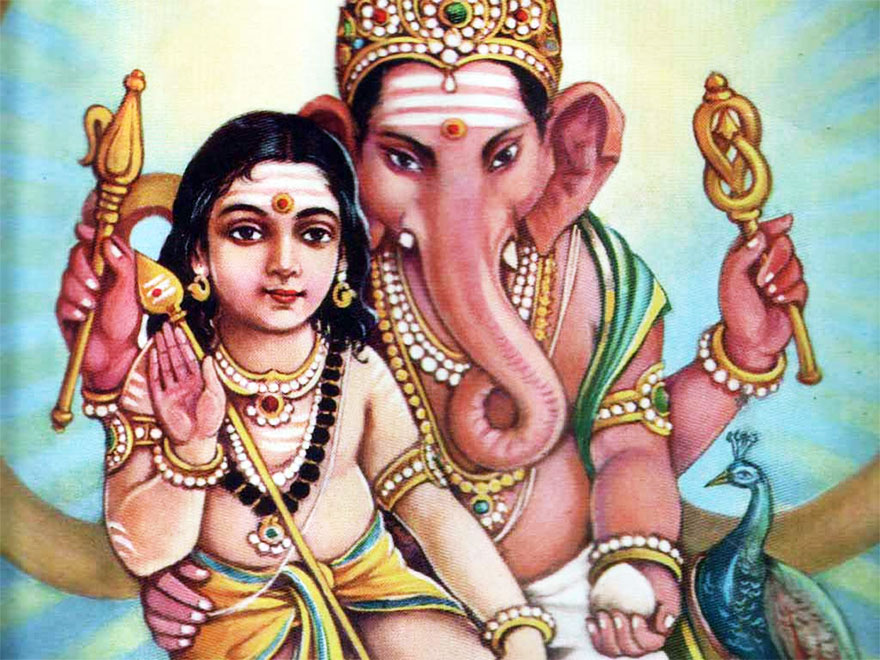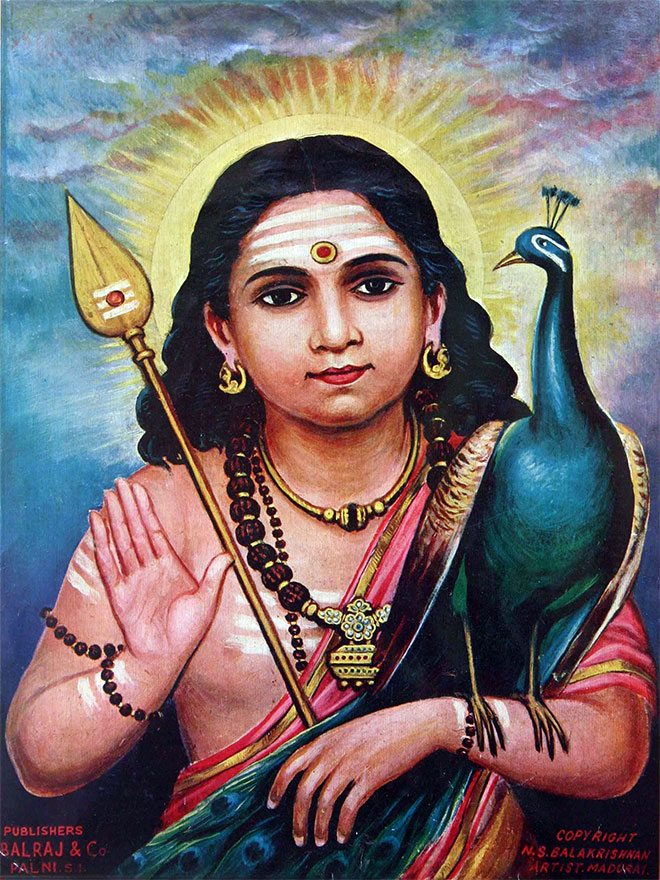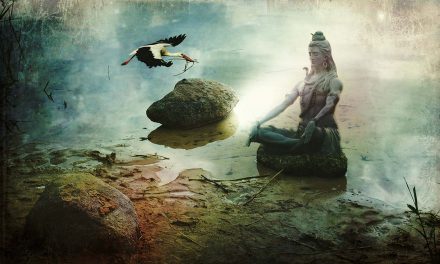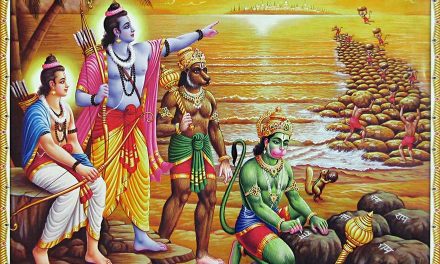Legend has it that a demon called Tarakasuran (tArakAsuran) had enslaved and tormented the Devas (dEva – demigod). He had acquired a boon from Brahma that he should be destroyed only by a power equal to Shiva and not even by Shiva himself. Tarakasuran believed that he had outsmarted God and had obtained immortality by asking such a boon for there is none equal to Shiva.
Tarakasuran still had his doubts. He asked Brahma who could be equal to Shiva. Brahma stated that a son born to Shiva would be equal to Shiva in all aspects and that he would destroy Tarakasuran. Shiva had become a recluse after the loss of Sati and Taraksuran was deluded into thinking that a son would never be born to Shiva. It was a shock to Tarakasuran when Shiva married Parvati, who was Sati reborn.
[wp_ad_camp_1]
However, there was a curse on Parvati. Rati is the wife of Manmadan, who was burned down by Shiva when at the request of the Devas he had tried to induce lust in Shiva’s mind for Parvati while she was serving him as a devotee. In her grief at the loss of her beloved, Rati had cursed Parvati that she would never be able to bear Shiva’s child even if she eventually won Shiva and married him. Once again Tarakasuran was deluded into thinking that a son would never be born to Shiva.
Tarakasuran had to be destroyed. Rati’s curse also had to materialize and come true. How could a child then be born to Parvati if she could not physically bear the child of Shiva? The all-knowing Shiva found a way. The five faced (panca vaktra) Shiva acquired a sixth face that looked (with concern and kindness) in the downward direction (adho mukha) at the suffering Devas and became Shanmukha (the six faced lord).
Six sparks emerged from the forehead of each of the six faces of Shiva and were carried by Agni (the god of fire) and Vayu (the wind god) to river Ganga. Six of the wives of the Sapta rishis (seven holy sages) held them in their wombs before depositing them on six lotus flowers at the shara vana (the forest of reeds). Six babies then emerged from the sparks that were nurtured by the six Karthigai ladies (a constellation of six stars). These six babies then became Shamukha – the six faced lord who is considered as the son of Shiva and Parvati. Shanmukha is also known as Muruga in the Tamil language. murugu in Tamil means handsome or beautiful and murugA means one who is very handsome. Muruga destroyed Tarakasura and his 2 brothers Simhamukha and Surapadma and freed the Devas.
The logical mind now starts wondering. How could it have been possible for a child to be born without the physical union of a male and a female? What is the logic behind this legend? Considering the scientific knowledge we have today we know that the physical union of a male and a female is not essential to produce a child.
The ovum of the female can be fertilized with the sperm of the male in an artificial environment – Test tube baby. Usually multiple (more than one) embryos are produced in this way. The embryos thus produced need the correct temperature (agni), vital air (vAyu) and fluids (The river Ganga) to survive. If the female who provided the ova, is unable to bear the embryos in her womb the embryos are placed in another female’s womb – Surrogate mother (the wives of the sapta rishis). If the babies are born prematurely the babies are nurtured in an incubator (shara vana) in a very warm environment (agni), with vital air (Oxygen – vAyu), fluids (the river Ganga) and nutrition (mother earth). The nurses in the neonatal ICU now care for this baby (Karthigai ladies). Even the breast milk for these babies can be provided by any other female other its own mother.
From a psychological standpoint Muruga can be considered as an alter ego of Shiva. In Latin, alter ego literally means the “second I”. According to the English dictionary, alter ego can also be thought of as a person’s clone or a second self. Alter ego can also refer to the second, hidden side of one’s own self, or a person vicariously liable for another. Sometimes parents liver their dreams through their children. They present to their children opportunities that they did not have. They attain joy a when their children achieve what they could not achieve. What Shiva could not achieve, he achieved through Muruga.
Why is this logic not presented to us in the first place? Why are we told the legends? Well, how can this logic be explained to a six year old? Would it even make sense to a six year old? Hence we need legends. We need to keep believing in them and if we keep contemplating on the legends, one day the logic will fall into place.
The handsome Muruga is know by six names – guhA (cave), for he is the secret that lives in the cave of Shiva’s heart, Kumara (the son of Parvati), Skanda – spilling – such as the seminal fluid or seed, as he was carried by Agni and Vayu, Gangeya as he was carried by river Ganga, Sharavana as he was nurtured in the shara vana – the forest of reeds and Karthikeya as he was raised by the 6 Karthigai ladies.














Swamiye saranam ayyappa. Really beautiful birth story of Shanmuga. In God’s creation every child is Muruga. We have to see the God in every child. Their gentle eyes, their actions. their doings etc. all are divine. If we want to inculcate divine qualities we must be like child hearted. Thanks for the article. Really we are very grateful to Indiadivine.org for their godly service.
Nice information
When you try to analize the story and says it is a legend only, you miss sacredness for it.
You should be making deeper questions. What is a son? How does union occur? What is creation?
These are questions a seeker would do… There lies the answers.
Lord Murugan, Karthikeya, Guhaha, Skanda, Shanmukha, Senani, Kumara, Subrahmanya, Gangeya, are some different names of Lord Brahman (Karthikeya) . Because the Brahman is one and the wholesole, which cannot be devided, cannot be seen with these eyes, which is guiding the whole world for doing karmas. You can call it as Brahma – Vishnu – Shive – Ganesha – Karthikeya – and so on but it is one and the only one and can be seen with the internal eye ( low choopu). But for practice one should concentrate on one lord to reach the goal (Paramathma).
Your a Soul. At Soul Level all knows all.
keerthi appa rao lord ayyappa and shanmuga are not one and the same….
If we seperate infinity from infinity the result is infinity
. infinity_infinity=infinity
Nice photographs and interesting material to read. DVJ
good narrations
You make to mistakes.
1- consider gods with human stories
2- apply western thoughts on indian minds.
that’s corruption
Now I come to understand how Muruga has all these various names like Skanda, Karthikeya, Shanmugha, Guru Guha, Saravana, etc. Thanks.
Pl send your articles regarding science and Spirituality.T Hank you.You should send your articles in telugu language.Thank you.
Thank you Nice article. Learned about Shanmukha the 6 faced god with 6 names and the story behind.
Thanks for sharing.
commendable explanation…very beautifully described…
Please accept my sincere gratitude for your opinions and comments and a special thanks to those who pointed out a blatant error, a misrepresentation, omissions, ambiguity, a spelling mistake and a grammatical error in this narration. Please accept my sincere apologies for my oversight. A sincere attempt will be made to correct all these deficiencies and to formulate appropriate and mutually satisfying responses to the comments raised and a corrected narrative will be posted soon.
Sorry for the misinformation in the previous comments post. Realized that it is going to take a long time to make all the corrections and rewrite the original narrative. Instead, this is the plan. The original narrative is going to left as it is. The points/issues that need to be corrected and re-addressed will be listed and numbered as an erratum in the comments section. One by one, they will be addressed and posted as an addendum to the original narrative. In the meantime, other related articles will be uploaded for those wishing to follow this trail. Your continued valued feedback is appreciated. Thank you for your tolerance, patience and forgiveness.
1. The first BLATANT ERROR that was pointed out: The use/usage of the word destroy in 4 places – …….that he should be destroyed, ……will destroy, Tarakasuran had to be destroyed and Muruga destroyed Tarakasura and his 2 brothers Simhamukha and Surapadma………………..
1. THE BLATANT ERROR:
Muruga or Shiva do not destroy.
Shiva is not the Lord of destruction.
Shiva did not destroy anything in the pat, is not destroying anything now and will not destroy anything in the future
Dear MNC:
purANa in saMskRtaM (Sanskrit) is = legend in English. All purANas are sacred. All languages are sacred. Hence a legend in any language is sacred and divine. Sacredness and sanctity do not get lost in translation. They get lost in perverse interpretation, improper pronunciation and improper splitting of words.
purANa/legend means an ancient phenomenon or occurrence in which the incident mentioned can be re-enacted in a drama or a dance or retold as a poem (epic) or a story or cast in a drawing, painting or on a movie screen or engraved in a sculpture using creativity and artistic imagination but cannot be reproduced in real life as we know and understand it (life) now. Various interpretations can be offered as long as the deep inner sacred meaning is not defiled.
The concept put forth in the legend however can be reproduced exactly in Science/Science research and Psychology. It is also seen in daily practical life as we live it now. If seen that way, the truth can be understood clearly and easily. Hence, legends are considered to be logically derived conclusions – siddhAnta – the end to the end.
nyAya sambaddha hRdaya nigamana = Logically derived conclusions. The heart hRdaya is where the operations of the mind take place and the mouth or the hand is through which the conclusions are expressed. The conclusions then come out as speech/writing.
The tamizh translation of the above phrase is tirugnyANa sambandaN uRai/urai seyda. Speech/writing – urai. uRai = residing place.
A particular legend glorifies a particular hero/heroine (nAyaka/nAyaki) or both who is/are the star/stars of that particular legend. He/She/They is/are considered as the luminary or the leading light of that legend and He/She/They Himself/Herself/Themselves is/are also called a Legend/Legends. Hopefully this answer has put to rest the concern that you raised.
I do not know the Telugu language well enough to write in Telugu. However, if a person with knowledge and scholarship in Telugu, Tamil, English and Sanskrit languages, Puranas and especially knowledge of a Tamil Text called Thirumanthiram and is invited to undertake that project. Please do not use this article as a reference article. It is strongly advised that the translator/interpreter study the original 3000 verses of Thirumanthiram with the Payiram under the guidance of an able guru who would give the correct meaning and interpretation before attempting to translate/interpret this article. Otherwise the danger is that the translation/interpretation may end up being perverse. Also do everything the guru says before attempting/publishing any translation/interpretation. Best wishes.
Dear MNC,
A son is an idea that is conceived to change the meaningless to meaningful. Union can occur in the mutual/non mutual presence or mutual/non mutual absence of desire, at the physical, mental, emotional and spiritual level. Creation is the infinite expansion of an ideal till it converges into itself.
Dear Shri Narasimhan,
According to my respected guru, brahmam has qualities /features that cannot express itself. In order to redefine itself brahmam has to descend to the next level – Shivam which has some features but not capable of full expression. Shivam redefines itself into Shiva and Shakti. Shiva redefines himself into Sadashiva, Vamadeva, Rudra, Vishnu and Brahma. Shakti redefines herself into Manonmani, Parvati, Raudri, Lakshmi and Saraswathi. Creation includes both perfection and imperfection. That is why Brahma is imperfect. The actions of Brahma, Vishnu and Rudra on the physical body have an order to follow and are interdependent. Mahadeva (the family man) is the concealing grace that allows all the worldly experiences (good and bad) to the mental body and Sadashiva is the liberating grace that liberates the mind from all worldly experiences
Dear Shri Narasimhan,
My respected guru advises the practice of Siva Raja Yoga as the most practical way to realize oneself. The last line of the Mutthuswamy Dikshitar Krithi – Shri guru guha tArayAshu mAm…..endorses this fact.
yOgi rAja yOga bEdha yukta manOlaya vinOda. However, you are welcome to choose the path/method/practice that best fits your needs. Hope this reply and the previous reply satisfy you.
aiyappA = venerable father – is considered to be the son of Shiva and Vishnu (as mOhiNi – the enchantress) and pArvati. aiyappA is also known as ShAstA (the beautiful one), shasta=beautiful. murugu=handsome and murugA=the handsome one. All babies are precious and beautiful, no matter to whom they are born from and to what they are born to. A seed is an amazing piece of God’s creation. That is why even weeds have beautiful flowers.
harihara suta – The legend and the logic – in the making – NEAR OR FAR?
Thank you for your encouragement. More articles on Science and Spirituality (The Legend and the Logic) in the making. Knowledge is the greatest wealth. It is to be shared.
viNAyakA – vina nAyakA – The Legend and the Logic – TO FOLLOW – follow the trail……………………
Infinity_infinity=infinity
Thank you for that spark of inspiration. It has ignited the flame of imagination.
A trip to INFINITY – EXPLORE INFINITY – A VIRTUAL PEN SHOW TO COME OUT SOON.
Thank you God for this beautiful mind you have given us.
IMAGINATION SHALL REMAKE TRADITION.
Destruction = meeting one’s end=meeting one’s maker=recycling=recreation just for fun. shamukha=sham+ukha – a good pot, roasted and ready to be used for cooking, not a spelling mistake after all, a! Ambiguity is puzzling, omissions have a purpose just like emissions, Miss Representation can be represented well as we go along. Follow the trail……………………….
HOPE ALL CONCERNS HAVE BEEN ADDRESSED AND ALL QUESTIONS HAVE BEEN ASWERED TO THE BEST OF AN ETERNAL STUDENT’S ABILITY. KEEP LEARNING.
Pleeeeeeeeeeeease provide feedback.
Thank you GOD for everything you have given us. Thank you GOD for everything you have not given us. For, YOU alone know what is right and what is wrong. mangalam – may everything be auspicious.